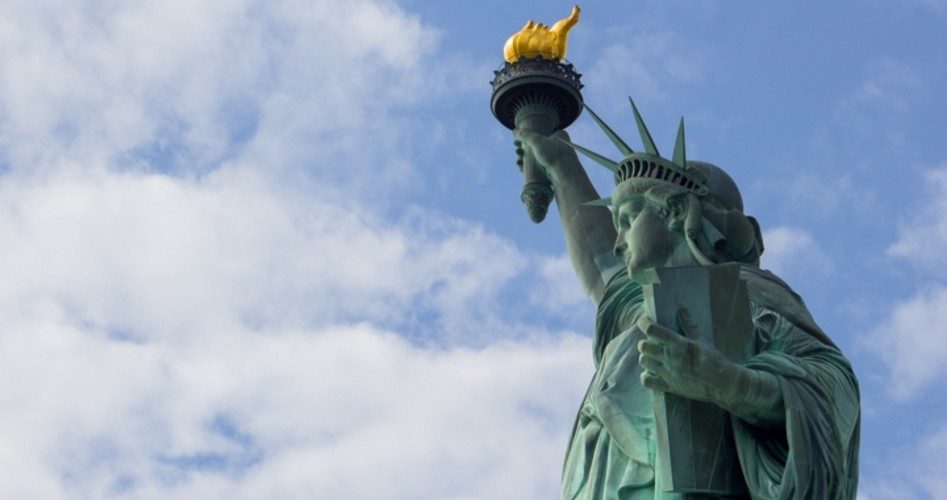
In order to protest the separation of children from their (alleged) parents who are entering the country illegally at the Mexican border, cartoonists have taken to using the Statue of Liberty as a symbol of open borders.
One cartoon shows the Statue of Liberty, depicted as a woman, pushing a shopping cart. While doing so, she is throwing three children into three different cages — named tired, poor, and huddled masses — clearly an allusion to the famous poem by Emma Lazarus found at the base of the real Statue of Liberty, found in New York Harbor.
Another cartoon depicts the Statue of Liberty as a mother, inside a jail, holding a child labeled “immigrant child.” In another cartoon, Attorney General Jeff Sessions is shown hanging the Statue of Liberty, while President Donald Trump stands to the side, smiling. Then, in a fourth cartoon, a Welcome Refugees of the World Sign is hanging just out of reach of the Statue of Liberty, with a smirking Trump telling the Statue that this is just part of our separation policy.
All of these cartoons are based on a misconception of the real meaning of the Statue of Liberty. Of course, the Statue celebrates liberty. But the original meaning of the statue has been lost, with many of today’s Americans thinking the Statue of Liberty was constructed to welcome immigrants.
In actuality, the statue was a gift from the people of France to the people of the United States. It was designed by Frédéric Auguste Bartholdi, a sculptor, and it was built by Gustave Eiffel, the man whose name is on the famous tower in Paris. The Statue of Liberty is depicted as a robed woman representing the Roman liberty goddess Libertas.
At her feet lies a broken chain, symbolizing the freedom that had been achieved by Americans.
When Bartholdi came into New York Harbor, he immediately visualized Bedloe’s Island as the perfect site for the Statue, because vessels arriving in the harbor had to sail past it. The island was owned by the U.S. government, and President Ulysses Grant told Bartholdi that he was sure that the statue could be placed there.
Even with such an ideal site, one problem, however, was that the project would require a great amount of money. Money was raised through various methods, and the poet Emma Lazarus was asked to donate a sonnet as part of the fundraising effort. Lazarus, a Jew, was busy at the time helping Jewish refugees in New York who were escaping anti-Semitic pogroms in eastern Europe. Because of this, she chose to write a sonnet to these desperately poor refugees entitled “The New Colossus.”
Lazarus was referencing the Colossus of Rhodes, which was one of the Seven Wonders of the Ancient World, as it also stood astride a harbor. Her intention was to contrast the liberty — including religious liberty — found in America with the persecution that was far too common in the Old World:
“Keep, ancient lands, your storied pomp!” cries she with silent lips. “Give me your tired, your poor, Your huddled masses yearning to breathe free, The wretched refuse of your teeming shore. Send these, the homeless, tempest-tost to me, I lift my lamp beside the golden door!”
In the years after the Statue was raised on Bedloe’s Island (soon renamed Liberty Island) in 1886, most of the immigrants from Europe came through New York Harbor, with the processing done at Ellis Island in the shadow of the Statue of Liberty. The statue had nothing to do with immigration, but not surprisingly, it came to be associated with immigration, as the imposing statue was the first thing the immigrants crossing the Atlantic Ocean to the United States saw in America. It was a site that no doubt was in their minds and hearts the rest of their lives.
But what was pulling all of these immigrants into America? After all, there were other nations in the world where these immigrants could go. In the case of Lazarus’ Jews, it was freedom from religious persecution. In other places, immigrants came for economic reasons, while others desired political liberty.
In all of these cases, however, it was liberty that made it all possible. Certainly, America was not the only place in the world in which liberty was an important value, and America had not always lived up to the principles of liberty incorporated into its founding documents, but the Statue of Liberty was created to honor an American reputation for liberty that already existed. This reputation was already well-established in the Old World.
No, the Statue of Liberty was not an icon constructed to promote some abstract right of immigration. It was liberty that drew the immigrants — the liberty to practice one’s religion, or to open one’s own business, or to simply run one’s own life as one wished.
Even Lazarus’ sonnet clearly states their desire — “yearning to breathe free.” The placement of such a monument outside Cuba, North Korea, Saudi Arabia, Zimbabwe, or China would be nonsensical. No one has to worry about a flood of immigrants — legal or illegal — into those nations. Anyone “yearning to breathe free” would find somewhere else to go —such as America.
Hopefully, whenever immigrants arrive in America, and eventually become voting citizens, they will not use their franchise to put into office politicians whose desire is to end America’s connection to liberty, replacing that connection with a liberty-destroying Welfare State.
Image: mauspat via iStock / Getty Images Plus


